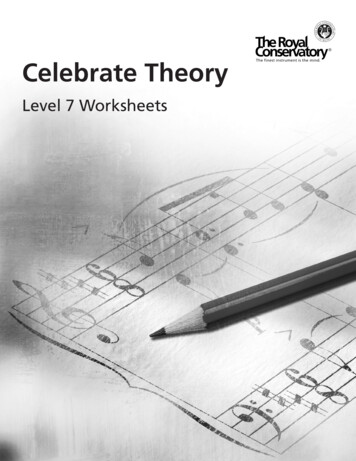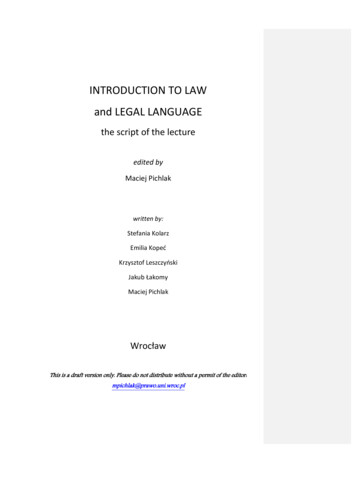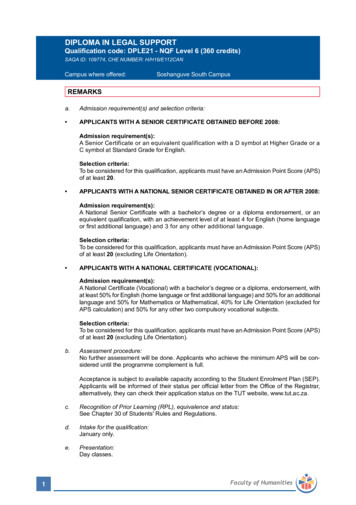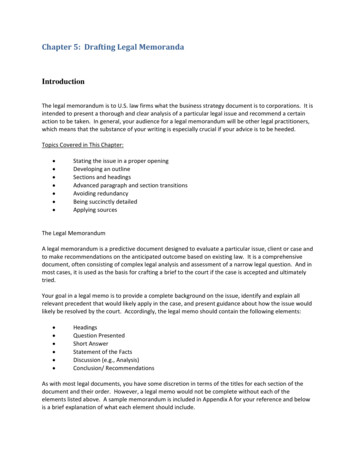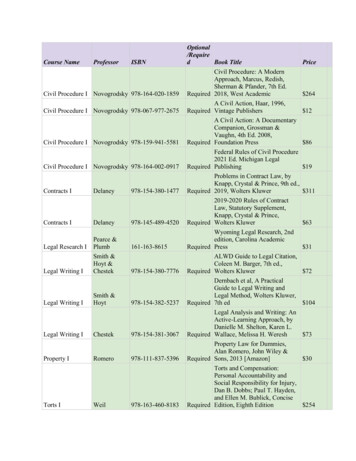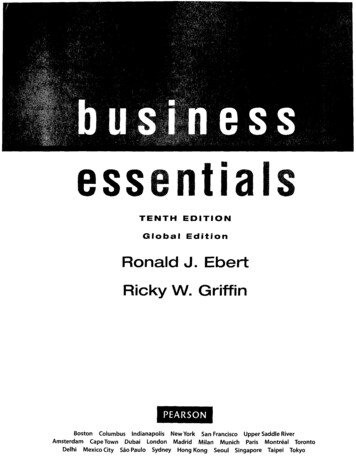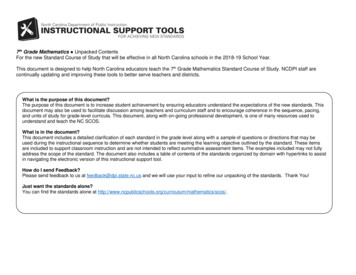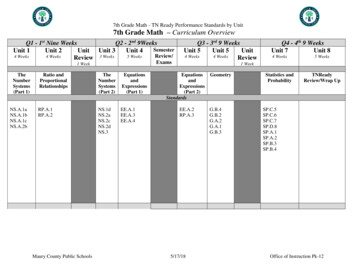
Transcription
Legal Environment of Business 7th Edition Kubasek Solutions ManualFull Download: The Legal Environment of Business: A Critical Thinking ApproachChapter 2Introduction to Law and the Legal Environmentof BusinessIntroductionTo promote an environment in which instructors and the students have a question-asking attitude,instructors should present each chapter as one that address several questions.Chapter Two addresses these questions: How can legal environment of business be defined?How can law and jurisprudence be defined? Do alternative definitions of law exist?Where does law come from?What are the classifications of law?What are the global dimensions of the legal environment of business?Chapter Two is significant because it provides background information that influences theway students think about cases and legal ideas. When instructors teach this chapter, they shouldemphasize on the significance of considering alternative perspectives.Achieving Teaching ExcellenceCreating a Student-Centered Classroom That Promotes Students’ Intellectual DevelopmentInstructors can probably choose this textbook over others in part because they wanted toencourage their students to engage in critical thinking about the law. This goal is important. Toachieve this goal, instructors will want students and their intellectual development to be the focusof what happens in class.First, this section explains alternative perspectives on how to conduct class. Second, thissection will explain why a specific type of student-centered classroom is likely to help instructorsachieve their goal of encouraging their students to engage in critical thinking.In The University Teacher as Artist, Joseph Axelrod describes different teaching styles.Axelrod classifies these teaching styles. One major category includes didactic styles. Didacticteaching styles do not encourage inquiry by the student. The other category includes evocative1Copyright 2015 Pearson Education, Inc. All rights reserved.Full download all chapters instantly please go to Solutions Manual, Test Bank site: testbanklive.com
The Legal Environment of Business: A Critical Thinking Approachstyles. These styles require student inquiry when completing the tasks the instructor has assigned.Axelrod explains that didactic teaching styles stress either knowledge acquired bymemorization, or skill mastery through repetition and practice. Evocative modes stress studentinquiry and discovery. A teaching style that encourages critical thinking is an evocative style.Within the category of evocative styles, different teaching styles emphasize differentcomponents. Some styles focus on the teacher, some on the learner, and some on the subjectmatter. A teaching style that stresses critical thinking is an evocative style that focuses on thelearner and his or her understanding of course material. Axelrod would call this style a studentcentered style rather than an instructor-centered style. A critical thinking approach assumes theteacher will create a classroom environment in which the students’ intellectual development isthe focus of classroom attention. A teacher who uses this approach would be likely to say what aprofessor in Axelrod’s book says, “I train minds.” Promoting critical thinking is one way to trainstudents’ minds.Now the question arises as to how instructors will know whether they have created a studentcentered classroom that emphasizes intellectual development. First, they will be talking less andlistening to their students more. Second, they will be emphasizing on higher-order thinking skillsrather than asking their students to recite principles and facts. Third, instructors will be observinghow students are doing at grasping the critical thinking model. They should not be watchinginstructors to see what a good critical thinker they are. Fourth, class time will be spent workingwith the material, rather than making sure they have “covered” everything.Reference: Joseph Axelrod, The University Teacher as Artist (Jossey-Bass, Inc., Publishers 1973).Chapter Overview, Topic Outline, and Discussion QuestionsChapter OverviewThis book is about the legal environment in which the business community operates today.Although the book concentrates on law and the legal variables that help shape business decisions,it has not overlooked the ethical, political, and economic questions that often arise in businessdecision making. This chapter is especially concerned with legal variables in the context ofcritical thinking. In addition, it examines the international dimensions of several areas of law.Instructors who want to encourage students to work with the material in class sometimesrealize they cannot always “cover” all the material in the book. After several years of notcovering everything, instructors should be comfortable knowing that the material encourages2Copyright 2015 Pearson Education, Inc. All rights reserved.
The Legal Environment of Business: A Critical Thinking Approachstudents to work on in class and is understood by most of them. Instructors can choose parts ofeach chapter that are especially challenging or confusing. This is the material that deserves themost attention in class. Some chapter material is easy, and students pick it up well on their own.In Chapter Two, the material that is the most challenging or confusing falls into thesesubsections: Definition of Law and Jurisprudence Classifications of LawAfter presenting a topic outline for Chapter Two, this section provides discussion questionsthat help students increase their understanding of the material presented in the two sections listedabove.Topic OutlineI. Definition of the Legal Environment of BusinessII. Definition of Law and JurisprudenceA. Natural Law SchoolB. Positivist SchoolC. Sociological SchoolD. American Realist SchoolE. Critical Legal Studies SchoolF. Feminist SchoolG. Law and Economics SchoolIII. Sources of LawA. The Legislature as a Source of Statutory LawB. The Judicial Branch as a Source of Case LawCase Law Precedents and the InternetC. The Executive Branch as a Source of LawTreaty MakingExecutive OrdersD. Administrative Agencies as a Source of LawIV. Classifications of LawA. Criminal Law and Civil LawB. Public and Private LawC. Substantive and Procedural LawSubstantive LawProcedural LawD. CyberlawV. Global Dimensions of the Legal Environment of BusinessVI. Summary3Copyright 2015 Pearson Education, Inc. All rights reserved.
The Legal Environment of Business: A Critical Thinking ApproachDiscussion Questions for Chapter Two1.In answering the question “What is Law?”, why is it appropriate to answer, “It depends?”The question “What is Law?” is not as straightforward as it appears. Most people would givean answer that shows their understanding and acceptance of the positivist school ofjurisprudence. However, a person’s answer to the question “What is Law?” depends onwhich school of jurisprudence the person prefers. For instance, a positivist thinker might saythat law is a set of rules created by the legislature that people must follow or they will bepunished or fined. A critical legal studies scholar might say law is an institution that protectsthose in power. Students should notice the difference in those two answers. Given the widerange of beliefs about the definition of law, it is wise to say the answer to the questiondepends on the school of jurisprudence a person prefers.2.How would an individual decide which school of jurisprudence a particular judge prefers?This question triggers many reminders. First, a judge, legal scholar, or thinker might agreewith more than one school of jurisprudence, or with some elements of more than one schoolof jurisprudence. For instance, feminist legal scholars and critical legal scholars share somebeliefs. It could be possible to agree with both of those theories to some extent. Second,judges, legal scholars, and thinkers rarely announce their preferred school of jurisprudence.(Some might even be confused about the schools of jurisprudence.) To figure out the view ajudge prefers, an individual would need to read their legal decisions and scholarly writingscarefully. An individual can infer their views from their writings or what they say in publicabout a particular decision.3.Which schools of jurisprudence probably have the fewest followers within the legalcommunity?Probably, critical legal studies and feminist views of jurisprudence have the fewestfollowers. Both evaluate the legal system in a structural way; they question the very structureof law as a societal institution. Most followers of these schools are legal scholars rather thanjudges or practicing attorneys. People engaged in the daily practice of law might want somekind of incremental legal reform, but they are unlikely to question law in a structural way oradvocate major changes.4.Create a fact situation that could end as both a civil and a criminal lawsuit.Instructors should encourage students to be creative with this one. For instance, a bankrobber was injured while committing a bank robbery. After collecting the money, it exploded4Copyright 2015 Pearson Education, Inc. All rights reserved.
The Legal Environment of Business: A Critical Thinking Approachin his pockets because a device attached to the money was poorly designed. The robberwould be prosecuted for the crime of bank robbery, and could sue the manufacturer of theexploding device under civil law. (This was a real case. The robber sued the manufacturerfrom jail, and lost.) A more realistic and common example would be one in which someoneengaged in driving while under the influence of alcohol, caused a car accident, and injuredsomeone. The driver would be prosecuted under criminal law, and the injured parties couldsue the driver civilly.5.Explain how a court’s decision (case law) might lead to changes in legislation (statutorylaw). Are there any situations in which this has happened?A legislature (either state or federal) might be so concerned about a judge’s decision that itwill pass a law that in effect reverses the judge’s decision. One example is the Civil RightsAct of 1991, which changed several decisions the U.S. Supreme Court had rendered.Congress was changing the Supreme Court’s decisions by changing statutory law.Answers to Critical Thinking about the Law Questions, Review Questions,Review Problems, and Case ProblemsSuggested Answers to Critical Thinking about the Law Questions1.Learning about relevant laws regarding business helps one understand what the law is, butdoes not help one evaluate legal arguments. The critical thinking questions that help oneevaluate legal arguments are: Does the legal argument contain significant ambiguity? What ethical norms are fundamental to the Court’s reasoning? How appropriate are the legal analogies? Is there relevant missing information?The question about ethical norms most clearly addresses the ethical component of the legalenvironment of business. Knowing the ethical norms that are fundamental to a court’sreasoning helps one decide whether to accept or reject the court’s conclusion.2.Knowing the school of thought the judge prefers helps one critically evaluate a judge’sreasoning because one can determine the assumptions the judge makes. For instance, if oneknows the judge prefers the critical legal studies view of jurisprudence, one knows the judgewould favor structural change in the legal system—he or she does not have to tell them. Onewould also know the judge is likely to prefer a definition of justice defined as to treat allhumans identically, regardless of class, race, gender, age, and so on. The critical legal studiesmovement strives to point out how the legal system perpetuates inequality.3.One might want to ask the lawyer whether their mutual respect for a particular school of5Copyright 2015 Pearson Education, Inc. All rights reserved.
The Legal Environment of Business: A Critical Thinking Approachjurisprudence will bring about the action they want. For instance, mutual respect for naturallaw might yield interesting discussions between people and their attorney, but it will do littleto help them pursue the landlord. One would also want to ask the lawyer basic questionsabout competence, the lawyer’s area of expertise, whether the lawyer has time to take on acase of this nature, and the lawyer’s fee.Answers to Review Questions2-1.The source of law is different in the sociological school’s definition of law and that of thefeminist school. The source of law for the sociological school of law is contemporarycommunity opinion and customs. In contrast the feminist school is based on jurisprudencethat reflects a male-dominated executive, legislative, and judicial system in whichwomen’s perspectives are ignored and women are victimized.2-2.The critical legal theorist school and the feminist school of jurisprudence are similarbecause both evaluate the legal system. Both find major inadequacies in the legal system.Critical legal theorists think the legal system protects economically privilegedindividuals; feminist scholars think the legal system protects the rights of men.2-3.The legislative branch (Article I) is the maker or creator of laws and for this reason it is asource of law. In addition to that statutory laws are made by the legislative branch.2-4.Statutory law is made by legislatures. Case law is made by judges.2-5.If the President vetoes a bill passed by the House and the Senate, the bill can become alaw if two-thirds of the Senate and House membership vote to override the veto.2-6.a.b.c.Public law is a classification of law that deals with the relationship of governmentto individual citizens. Private law is generally concerned with the enforcement ofprivate duties.In criminal law, a prosecutor aims to prove beyond a reasonable doubt that thedefendant committed a crime and should be punished. In civil law, a privateindividual or business tries to show by the preponderance of the evidence thatanother private individual or business is liable and should have to compensate theplaintiff.Felonies are punishable by incarceration in a state penitentiary. Misdemeanors areusually punishable by shorter periods of imprisonment in a county or city jail.Answers to Review Problems2-7.Justice A belongs to the positivist school of jurisprudence. One knows that because this6Copyright 2015 Pearson Education, Inc. All rights reserved.
The Legal Environment of Business: A Critical Thinking Approachjustice is unwilling to look beyond statutes and case precedents in interpreting the law.2-8.Justice B is a natural law thinker. One knows that because this justice is willing to ignoreman-made law and rule based upon something higher—the laws of nature.2-9.Justice C is a sociological thinker. This justice bases her decision on contemporarycommunity customs or thought.2-10. A judge who follows the natural law school of thought would hear out the case and basedon the evidence presented would make his or her decision. These value judgments wouldremain unchanged as there is an absolute source of law. Therefore, the decision made inthis case would be dependent on the merits of the case.2-11. Precedent refers to case law courts follow. Judges interpret legislation on a case-by-casebasis. These cases establish a line of authoritative cases on a particular subject that mustbe followed by lower courts. Here, the precedent tells Marshall his legal rights. Theattorney can predict that Marshall will win a lawsuit to collect the reasonable value of hiswork.2-12. No, the California court does not have to follow decisions from North Dakota and Ohio.The California appellate court must listen to higher courts in California, but not highercourts in other states. The California court might consider the North Dakota and Ohiocase law, but it is not required to do so.Answers to Case Problems2-13. Students should note that ethical issues such as the one raised in this case do not getresolved necessarily by exploring the legal issue that brought the case before the court inthe first place. Rather than focusing on whether the practices of Myspace qualify ascopyright infringement, the court concentrated on whether Myspace’s counsel should bedisqualified because of its past association with Universal Music Group. The court ruledthat Myspace’s counsel should not be disqualified as long as it met several conditions. Inthis case, the court focused on which should hold more weight, the current client of thelaw firm, Myspace’s, right to counsel of its choice or the former client, Universal MusicGroup’s, right to maintain its confidentiality. Using a sociological approach, the courtused California Rules of Professional Conduct Rule 3-310 and decided it was mostimportant to preserve the public’s trust in the integrity of California attorneys and the bar.The goal of this court was to uphold community customs and assume that the law firmwould act ethically. If another school of thought had been used, such as the natural orpositivist approach, the verdict may have been different. A judge using natural philosophymight focus on how it is unreasonable or unnatural for a law firm to represent opposing7Copyright 2015 Pearson Education, Inc. All rights reserved.
The Legal Environment of Business: A Critical Thinking Approachclients, whereas a judge using positivist philosophy might concentrate solely on the wordswithin the law and not on its affects on the public.2-14. Yes, Vermont’s marriage license law violates same-sex couples’ rights under theVermont Constitution. The court ruled that the State had failed to provide a reasonableand just basis for excluding same-sex couples from benefits incident to Vermont’s civilmarriage license. The court indicated that a parallel “domestic partnership” system wouldmeet Vermont’s constitutional guarantee of “the common benefit, protection, and securityof the law.”2-15. No. The court ruled that Margaret was allowed to sue her husband for damages in thecase. In making this ruling, the court overruled the judicially created doctrine thatprevented one spouse from suing another. The court did so as an act of fairness. They didnot want the family to suffer the financial consequences of the accident simply because ofthe husband’s negligence.2-16. The Supreme Court ruled in favor of the individual workers. Now, employees have theburden of proof and can therefore argue that there is no “reasonable” factor than ageinvolved in their termination.2-17. A & M Records won. The works at issue in the case were copyrighted, the plaintiffswould be likely to prove vicarious infringement, and the “safe harbor” provision of theDigital Millennium Copyright Act protects A & M.2-18. The court ruled that Roommate.com was immune from the Fair Housing Act charges,because of Section 230 of the Communications Decency Act. Section 230 states that“interactive computer services” acting as “service providers” are not responsible forinformation that has been provided by another “information content provider.” In thiscase, Roommate.com was seen as both a service provider and an information contentprovider, but the court emphasized that in close cases, the ruling should be in favor ofSection 230 immunity. The court could have focused on Roommate.com being a serviceprovider or an information content provider and based on its interpretation, the verdictwould differ. In this case, the court focused on Roommate.com as a service provider andused a broad interpretation of Section 230 immunity. Not all judges would view such aruling as prudent.Thinking Critically about Relevant Legal Issues1.The issue here is framed in a very optimistic, naturalistic way. In an essay, one would focuson the benefits of this type of thinking and the best way to ensure complete objectivity. Theconclusion would contain an account of how many problems and squabbles over objectivity8Copyright 2015 Pearson Education, Inc. All rights reserved.
Legal Environment of Business 7th Edition Kubasek Solutions ManualFull Download: The Legal Environment of Business: A Critical Thinking Approachwould cease if the naturalistic approach was taken.2.The author here seems to value justice, defined as moral absolutes that make clear what isgood. The author may also value tradition, as what the author assumes is that what is “good”is what is conventionally right.3.Good here means what is conventionally right. Evil means what is wrong. Both of theseterms are ambiguous and take away from the argument. Again, the author assumes that allpeople are thinking the same way and live in the same environment.4.Students would probably make a more realistic argument, citing differences in areas acrossthe country in culture, religion, and so on. Sometimes absolute, conventional good is notsynonymous with right.9Copyright 2015 Pearson Education, Inc. All rights reserved.Full download all chapters instantly please go to Solutions Manual, Test Bank site: testbanklive.com
This book is about the legal environment in which the business community operates today. Although the book concentrates on law and the legal variables that help shape business decisions, it has not overlooked the ethical, political, and economic questions that often arise in business
